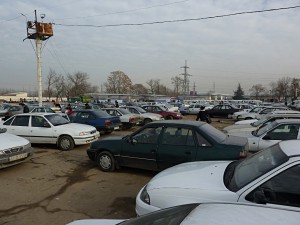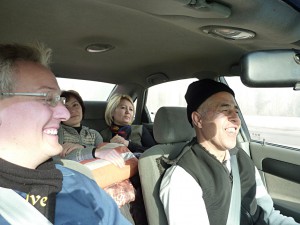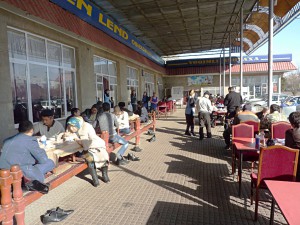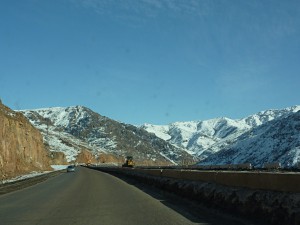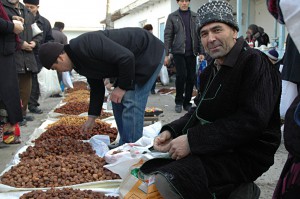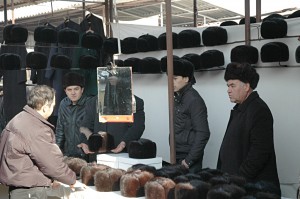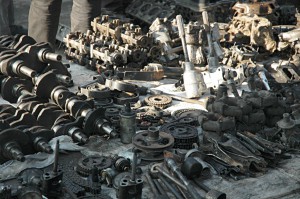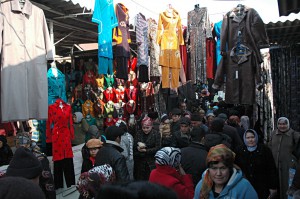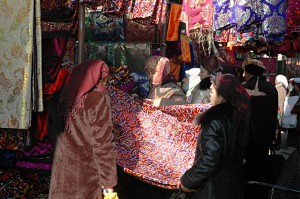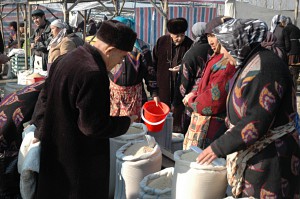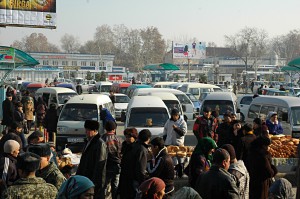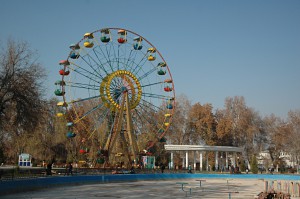After the oriental and the Russian part followed the third yet again different part of Uzbekistan, which is the traditional Uzbek part in the Fergana Valley. The valley is the country’s most important agricultural region and is mainly settled by ethnic Uzbeks. One could observe this by the people’s dresses, their language and their religion.
The Fergana Valley, the Eastern most part of Uzbekistan, has a few interesting destinations to offer. Since my time was limited and because of the timing, I decided to visit the city of Fergana, the capital of the Fergana province. Other cities, like for example Kokand, have more tourist attractions to offer, but the huge market taking place near Fergana was something I did not want to miss.
To reach the Fergana Valley there is only one reasonable way: shared taxis. As in probably all cities, they leave in well defined places, which was near the Kuyluk Bazaar in Tashkent for the Fergana Valley. Of course the Kuyluk Bazaar was located at the other end of the city with respect to my accommodation. For a resonable price I managed to cross the city in a shared taxi. The only problem was that the taxi stop was still quite a distance from the bazaar. The driver of course offered to bring me there for a quite impressive price. However I didn’t argue too much, since it was only 1US$ too much, which I could spare.
Right when we arrived at the shared taxi station, my ride was surrounded by numerous people, all wanting to offer me a ride to somewhere. One has to be a bit careful, since one of them is usually number one, who gets the right for a first offer. I followed the guy, since the price seemed alright without even negotiating too hard. On the way to the car I became curious whether I had understood him correctly and double checked. It turned out that he was talking about dollars while I was talking about thousands of Som. This meant he expected a price about 2.5 times of what I expected. Fortunately I was able to correct the price to a reasonable albeit not optimal level. At least I was allowed to sit in the front seat of the car. When we were kids, we always had fights who could sit in front. In Uzbekistan this issue is easily taken care of by money.
The drive led from Tashkent to the South-East via Angren, where we stopped for lunch, and across the Kamchik Pass to Kokand and finally Fergana. Since there were ethnic clashes with large demstrations in the Fergana Valley in 2005, the region still today observes a relatively high police presence. Especially the city of Andijon, back then the center of all, apparently is affected by this. The influence all this had on my journey was that my passport had to be registered at the Kamchik Pass, a procedure I knew more than well enough from Turkmenistan. This time it was the driver who provided this small service.
Due to the two ladys who were riding along, we had enough entertainment during the drive. The two of them are Ph.D. students in electrical engineering working on gas identification. As the ride progressed the two dared more and more to speak English, which I appreciated very much. When they reached the limits of their English knowledge I occasionally was able to help out with my little bit of Russian and Uzbek, for example when we drove by the historical palace in Kokand. Very practical if one has traveled through Iran and other parts of Uzbekistan before and seen many Args or Arks.
The driver initially had told me the drive would take about 5 hours, which turned out to be very optimistic. I assumed it was his way of driving why it took so long… But he provided the service to deliver all of the passengers to their final destinations in Fergana. This was very convenient for me, since the B&B where I originally wanted to stay is closed during the cold time of the year. The driver then called a second place, which was open but I probably would not have found without the help of the driver. I can recommend everybody who will be staying at Valentina’s Guesthouse to call ahead and make out a meeting point or ask for a pick up. As Majdas in Mostar, this place is a regular appartment in a large building without any signposts. The buildings have an erie look, which would not indicate a nice and cozy appartment to me.
After a Saturday of shared taxis, I opted for a Sunday of markets. From my guide book I knew that in a neighboring town of Fergana, in Kumtepa, there is a huge market on Thursdays and Sundays. Since the area around Margilon, in which’s vicinity Kumtepa lies, is the most conservative part of the Fergana Valley, the market was going to be full of traditionally clothed people selling and buying goods.
The market finally was one of the highlights of Uzbekistan. I am generally a fan of markets, but this one had such an extensive offer and even though there is a lot of negotiation and hard work going on, the people still seem to be relaxed and are in a good mood and are open to the few tourists who show up at this place. Many people happily posed for the camera and even thanked me for taking their picture and showing it to them.
As far as the goods on sale were concerned, there were the usual groceries of what nature had to offer in the valley. This reached from potatoes, carots and onions to diverse kinds of fruits and to nuts and rice. As on many markets there were once again large bags of spices on display. There also was a butchers corner, where one could get fresh meat and sausages.
In another part of the market, clothing was being offered. Besides shoes and boots as well as pants and jackets, the offer included diverse kinds of hats. One salesman wanted to sell me a traditional Uzbek hat, which I politely declined, since I still have my original Adidas hat, which I bought in Turkmenistan. There were also different kinds of scarves and linen and silk by the meter. Uzbekistan is the third largest producer of silk in the world, the area around Fergana being the center of it. On another weekday I would have joined a tour in one of the silk factories, but apparently they are closed on Sundays.
I always find the corners of these bazaars interesting, where technical products are sold. Center of it all are usually used and unused spare parts for the cars. Even engines are taken apart and individuals parts of them are sold. This system works quite well in Uzbekistan, since the people are mainly driving three models of cars which are produced in Andijon.
Eventually I has seen enough of the bazaar in Kumtepa and took a bus back to Fergana, where I stepped into the next bazaar. There I found a nice restaurant with self-service, where I sat down and enjoyed lunch.
I intended to use the afternoon to further discover the city of Fergana, but os ever so often during this trip I got interrupted doing so. This time it was Abbas, a student of Uzbek literature, who intends to get a minor degree in English. He claimed to have a vocabulary of 5000 to 6000 words in English. After our quite extended conversation I could not get past the idea that he might have an error in the order of magnitude and that he actually has a vocabulary of 500 to 600 words. We had a nice discussion anyway during which we strolled through the city and he showed me the student housing, at least from the outside. When I asked him about his intentions after his studies he would like to go to Europe. He then inquired about the need for teachers of Uzbek literature in Europe. I told him that the demand would probably be quite limited. Later in the afternoon, we said our goodbyes and I headed back to my guesthouse where I rested for a little bit.
In the evening I went out again for some nice dinner and later on I went through my many photos of the market and sorted them out and wrote the first part of this blog post.
On Monday morning I packed my backpack and during the payment finally met the French guests who had stayed the previous three nights at the guesthouse. We exchange a few pieces of information, but the two were again in quite a hurry, since they wanted to visit Kokand and move on to Tashkent on the same day to hopefully pick up a Turkmen visa the next day. Together we walked to the bazaar, around which all the transport options from Fergana can be found. On the way they told me a little bit more about themselves and how they both had worked in Istanbul from where they started their journey. The traveled North of the Caspian Sea to visit Central Asia and were now heading towards Iran and Pakistan to go to India and finally China. In total they want to travel for about 11 months. They certainly have an advantage in Central Asia by knowing the Turkish language, since most of the countries’ main languages are related to Turkish. This would be a change in strategy if I was to do this trip again, I would rather learn some Turkish instead of Russian. Nevertheless I would still learn the Cyrillic alphabet.
At the bazaar I had to wait about 5 minutes until a marhrutka to Andijon showed up. After another 15 minutes the minibus was full and we set off to the destination. From what I saw from the bus, it would be well worth spending some more time in the Fergana Valley. Nice little villages with their distinct architecture, omnipresent bazaars and the orchards are integral parts of the country side. The valley definitely has its own character which is very different from the rest of the country. The people are also more relaxed and more hospitable than the rest of Uzbekistan. Quite a few people in the marshrutka wanted to know where I was from and where I was headed. A lady even gave me an apple as a small present when we reached Andijon.
In Andijon my trip came to an unintended halt. According to my guide book, there is plenty of transport going from Andijon to Dustlyk on the Kyrgyz border. But either my timing was really bad or that statement is only true for the warm months. A driver wanted to provide an individual taxi service to me for an extraordinary price. It was difficulat to explain first to him and then to his father that I was not going to pay that price and that he should find three more passengers. Apparently it was lunch time and thus no passengers showed up for 2 hours, but then the three were found rather quickly. At 1:20pm we finally left Andijon for Dustlyk which we reached after a quick change of vehicle at 2pm.
Since there were few passengers interested in going to the border, I expected a short queue there. Finally there were about 30 people in front of me at the gate. The customs officers seemed to be coming back from their lunch break, since at first there was one person going through every few minutes. Suddenly the queue started to move quicker and the pushing and shoving started. Especially the group of older ladies seemed to be quite in a hurry. Eventually it was my turn to explain to the officer where I had travelled in Uzbekistan.
Next step in the process was the customs declaration. I remembered that the amount of money I took out of Uzbekistan had to b smaller than the amount I had brought into the country. Due to this rule I had packed some of the money at the bottom of my backpack, since I violated the law… When filling in the declarations form I was approached by a couple whether I could fill in their forms as well. The thing seemed a little bit risky to me, since I had no idea what I had to fill in for them in their language. But since they had nothing to write with, I left them my pen. When queuing with the filled in form, the responsible officer again had to remind the old ladys to stay in line like everybody else. Against all fears I did not have to show the officer my money, but I could pass without any problems.
The luggage control however was a little less harmless. The following officer was really interested in the contents of my backpack, such that I had to start unpacking section after section. After about a half of the check he was diverted by somebody else and told me to pack everything and move on. I readily obliged and queued for the last passport check in Uzbekistan. That officer was friendly enough not to check all my registration slips, but just to stamp my passport and let me pass. Apparently this is one of the points which take a lot of time when leaving Uzbekistan. The whole procedure took around an hour and a half.
The Kyrgyz officers then were really friendly, noted my presence and stamped my passport. That was it! Entering Kyrgyzstan didn’t even take 10 minnutes. The border crossing showed once again how much a police state Uzbekistan really is. When travelling the tourist route, besides Tashkent, there is very little police presence. But entering and leaving the country is a major hassle and a very good proof for the registration mania of the apparatus.
Once in Kyrgyzstan I immediately changed some money to at least be able to pay for the bus ride to Osh. Fortunately I had written down the most important information such that I could take a cheap marshrutka instead of an expensive taxi to the bazaar.
Now I had to readjust to a different country again, since Uzbekistan is much cleaner than Kyrgyzstan. The construction ruines were another new sight to which I had to adjust. On the other hand I was forced to get back to a reasonable currency, where one did not have to carry half a backpack of bills around. The only thing that remained the same were the languages.

